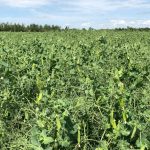
Tag Archives beans

Pulse weekly outlook: Smaller North American dry bean crops to underpin prices
Canada's edible bean crop estimated smallest since 2016

Pulse weekly outlook: Smaller yields than last year in Saskatchewan
Pulse production seen varying by location

Bean crops take yield hit
Lack of summer rains lowered early harvest soybean and dry bean yields, judging by the first beans to hit the bin
HARVEST Lack of summer rains lowered early harvest soybean and dry bean yields, judging by the first beans to hit the bin
Acres are up but yields are trending down for soybeans and dry beans across the province this year, according to Manitoba Agriculture pulse specialist Dennis Lange. “The key word this year is variability,” he said. “It all depends on when you got that rain, or if you got that rain. “If you got that rain, generally, harvest
Pulse weekly outlook: Lentils, peas show large declines in StatCan report
Chickpea, soy production expected up on the year

Pulse weekly outlook: AAFC trims production numbers
Lentil, chickpea prices up after report

Pulse weekly outlook: recent rains could stabilize crops
Prices for pulses across Western Canada have been steady

Pulse weekly outlook: Fewer growers signing up their green lentils
'A lot of interest' seen for red lentils

Pulse weekly outlook: Manitoba crops get good start but need rain
Some bean growers seek moisture at lower planting depths

Rangelands to get global spotlight
2026 will be the UN International Year of Rangelands and Pastoralists, and local forage advocates are glad to see it

Pulse weekly outlook: Seeding to start in Manitoba, Saskatchewan
Saskatchewan lentils expected to lose acres to wheat, canola






